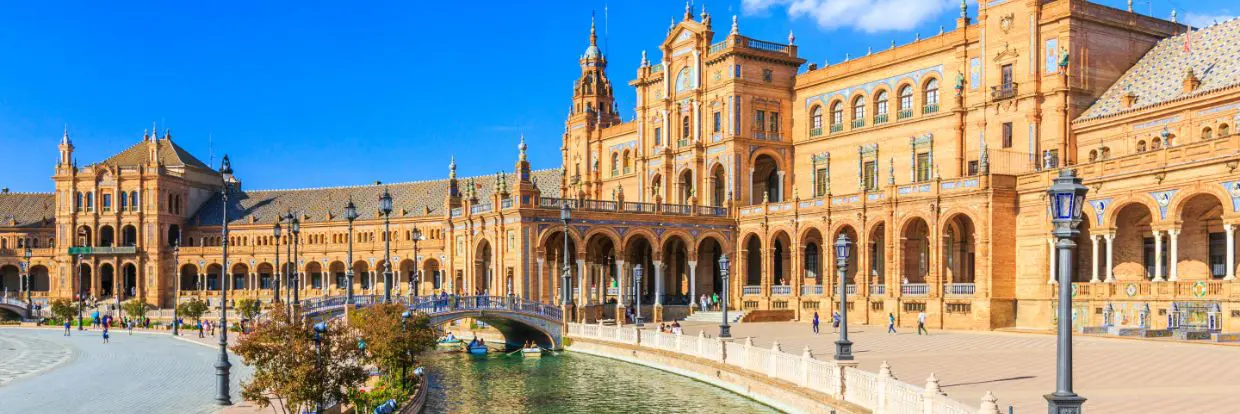How about a trip to Spain South

 A Brief Summary
A Brief Summary
The southern regions of Spain, largely the province of Andalusia (or Andalucía!), is what many think of as true Spain. The year-round sunshine, the toasty-hot summers, rolling hills dotted with large, historic cities such as Seville, Cordoba and Granada, hugely popular coastal cities such as Malaga and Marbella, with plentiful small towns and villages offering a much quieter and more leisurely taste of southern Spain, like Ronda, Nerja, Cadiz or Huelva.
Seville is the largest town in southern Spain and one which has an incredible history, dating all the way back, in detailed and architectural evidence, several hundred years and despite being a large city, it doesn’t feel vast in the way Madrid or Barcelona do. It feels much more slow-paced and eminently doable on foot. Speaking of feet, you cannot miss a live Flamenco dance while you’re here… but do feel free to give bull-fighting a very wide berth!
Granada is dominated by the sprawling and highly impressive Alhambra Palace, set atop the highest hill in the city and an absolute must-visit while you’re here. The rest of the city is littered with charming back-streets, lively tapas bars in the late evening and like most towns in Spain, the entertainment and watering holes are found in and around the large squares dotted around the city. Cordoba is low-rise, charming, older-world feeling town with a distinctly medieval feel to it, with its small back streets and understated way of life.
For beaches, overt displays of wealth, tans, jewellery and other materialistic delights, head to Marbella or Malaga. The harbour in Marbella is akin to Cannes or Monaco, with the large yachts, gaudy watches and supercars crawling through the narrow streets at a snails pace, often driven by those barely old enough to have a drivers license and yet with more money than most people make in a lifetime. It’s not for everyone, but neither is the opera or heavy metal music, so hey, you choose!
The other noteworthy aspect of this region is also the geography, with the Sierra Nevada mountains a wonderful break from the heat of the lowlands and a superb place for cycling, hiking or generally getting the heart-racing with more than just the beautiful vistas on offer!
 Location
Location

 About the Weather
About the Weather
Spain’s far southern coast has a sunny, warm and relatively dry climate, but with wet periods during the winter months from Nov to Feb. Temperatures at this time average 18°c by day and 8°c by night, but can be above 25°c during particularly warm periods. Rain usually falls infrequently, but can be heavy and thundery when storms last few a few days at a time. Spring is warm or very warm and very sunny by May, with 10 hours of sunshine a day. Rain also reduces to near-nothing by May. Summers are virtually rainless and hot and sunny, averaging 10-12 hours sunshine a day, 30°c and moderate humidity, often cooled by sea breezes. Very hot weather occurs a few times a year bringing temperatures over 40°c. Autumn is very warm in Sep and down to 20°c by Nov, mostly sunny until late Oct and only really noticeably wet by early Nov
 Travel by Air (from UK)
Travel by Air (from UK)
Direct Flight
Yes
3 Hours
(Avg from UK)
 Travel by Air (from UK)
Travel by Air (from UK)
will take approx...
<4 Hours
(Avg from UK)
 Weather Summary
Weather Summary
Average Rainfall
(per month)
69mm
Average Sunlight
(per day)
5 (hrs)
Average High Temperature
16.8°C
Average Low
7.4°C
 Cost of living
Cost of living
 Alcohol
Alcohol
 Crime
Crime
 LGBTQ+
LGBTQ+
 Visas
Visas
So does that sound good? If so, it’s time to get booking and get out there!
Trippee is proud to partner with some of the best names in the travel industry, and we only work with accredited and licensed companies so you can always feel safe trusting a link from us.

